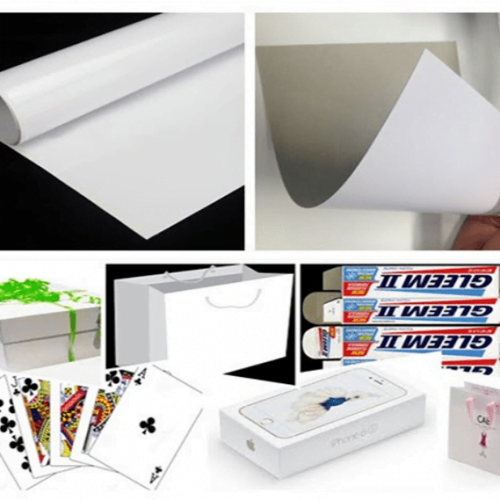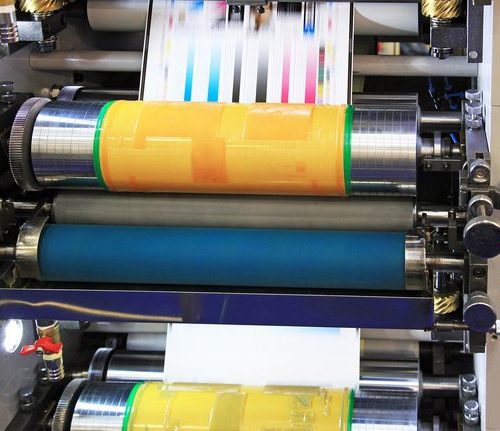There are 2 types of offset printers or roll offset printers, each with its own advantages, suitable for different printing needs. However, sheet printing is more commonly used.
Types of Offset Printers
According to the type of printing , there are 2 types of offset printers commonly used in the market:
Roll offset printing machine
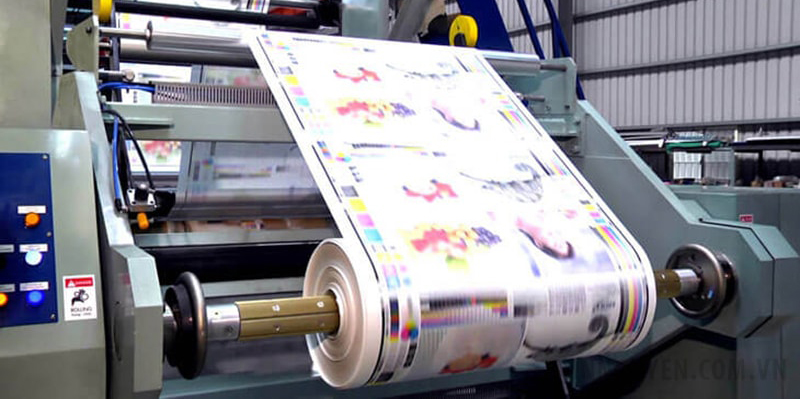
These printers automatically feed wide rolls of paper from one ink station to another in a seamless system, where each ink color is appropriately distributed for each page. After printing is finished, the prints will automatically roll up into a large curl.
Roll-to-roll printers are typically used to print 10,000 or more copies of multi-page documents such as magazines, books and catalogs, or bulk decals and labels. However, if you choose to print on rolls, the Flexo printing technique will be cheaper, so it is used more.
To better understand Flexo printing technique, you can learn more in detail in Flexo printing article .
Sheet offset printing machine
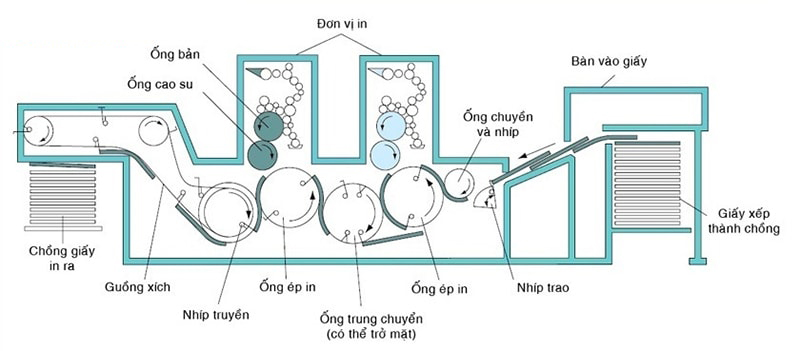
The printed material is divided into small plates, which in turn pass through the different color axes of the printer, and finally each finished plate is taken out of the printer and stacked in thick piles. Speeds range from 5,000 to 20,000 sheets per hour.
Sheet printers can handle a wider range of media with more thickness than roll printers. Also, printers of this type come in a variety of print sizes: smaller sheet presses can handle papers as small as 4 x 6 inches. Larger presses can handle sheets up to 40 in. X 26 in.
If roll Offset printing is not commonly used, Offset printing is very popular because it has many different printing sizes, the number of prints is from 5000 sheets and can be printed on thicker materials than roll printing.
According to printing color , can be divided into 2-color and 4-color offset printing machine, printing machine more than 4 colors.
- 2-color printer includes 2 ink rollers. 2-color machine has fewer colors, less ability to mix colors, cheaper price. It is often used to print low-color prints such as leaflets, black and white books, etc.
- 4-color printer with 4 ink rollers. This type of machine is popularly used because it has many colors and can be mixed with many different colors. They are used to print books, magazines, product packaging, other publications, etc.
- Printing machine more than 4 colors: To meet the requirements of customers ordering printing, offset printing machines of 5, 6 colors were born to be able to mix many colors together to form novel colors such as emulsion, bronze. … the difference with 4-color printers is that there are more mixed color boxes, 5-color printers with 1 more box, 6-color printers with 2 more boxes, …
There are also some other types of offset printing machines such as: mini offset printing machine, 1-sided offset printing machine, 2-sided offset printing machine , …
Advantages of offset printing technology
No matter how different types of printers are classified with different characteristics, they all have one thing in common that is extremely good product quality. It’s understandable why they’re becoming more and more popular day by day.
- When printing, ink will be printed on offset plates, also known as rubber sheets first. Then with pressing the image from this offset plate onto the paper. This printing technique will help limit the phenomenon of water getting on the paper according to the ink when used with lithography.
- The image printed on the product is sharp and clean. Very good quality, pretty durable grip.
- Can be used to print for many products, on many different material surfaces such as fabric, wood, leather, paper, metal, etc. It can even print on uneven surfaces.
- Prints are made more easily.
- Prints have a longer lifespan, significantly longer usage time than other printing techniques. The simple reason is that it is not directly in contact with the surface to be printed.
Structure of offset printer
An offset printer consists of the following main parts: a paper supply unit, one or more printing units, feeders to pass paper through the printer, a paper output unit and auxiliary parts. add as printer console.
When the machine is running, the media is fed through the paper supply unit, then the transfer batches (feeder shafts) will send the media through the printers (1 color each), finally the finished print. exits the printer by the print return unit (paper output unit). (Figure below)
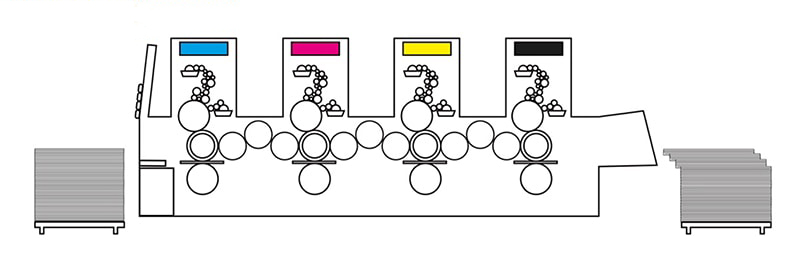
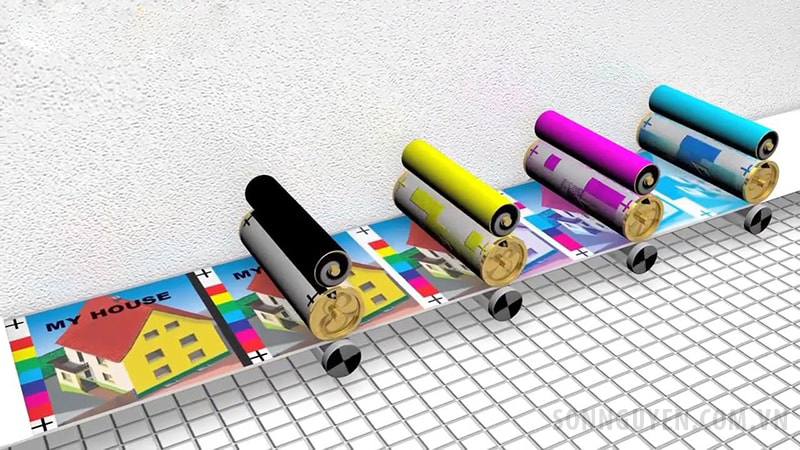
A printing unit (color press) in an offset printer usually has three main shafts with a humidifying system and a system for rubbing ink on the printing plate:
- Plate spool (Screen Drum): is a metal (usually aluminum) tube shaft, on which the printing element captures ink and the non-printed element captures water.
- Rubber tube (Offset drum): is a tube bearing an offset rubber sheet, composed of a layer of cloth wrapped with neoprene to transmit the image from the printing mold to the surface of the printed material.
- Press tube (Printing drum): is a rotating shaft that is always in contact with the rubber tube, which is responsible for transferring paper and other printing materials.
- Humidification system: is a system of batches moistened with a humidifying solution containing additives such as acids, gum arabic, isopropyl alcohol or other wetting agents.
When making prints, the unprinted parts of the image will be hydrophilic. Therefore, when the wetting agent (containing arabic gum) is rubbed over the entire printout, the non-printed portion of the image adsorbs a thin layer of arabic gum that produces a hydrophilic substance, while the hydrophobic portion of the printed image that repels water will not sticky. As a result, when rubbing ink, the part of the image that does not print does not stick to the ink, the part of the printed image that sticks to the ink.
Ink supply system: is a system of ink rub batches for prints. Other important ingredients.
- This system has 4 basic functions as follows: Directing ink from the ink tray lot to the printing plate. Separates the thick ink layer into a thin layer of ink evenly on the transfer batches. Rub ink onto the printed elements on the plate. Removes re-ink on the rub batch from previous print jobs.
- Structure of the ink supply unit:
- Ink tray: Where to store ink to print
- Dot lot (transfer lot): is a rotating batch of contact between the ink tray lot and the first batch of the ink supply system, usually the roller in the ink supply system.
- Canopy and floor rollers: are gears and slugs that can not only rotate but also move horizontally with the pipe axis from left to right Ink trough, two sides of the ink trough, scraper and ink tray and is responsible for rubbing thin layers of ink on the lots and erasing the previous layers of ink on the rollers.
- Intermediate lots: are movement lots based on contact with other moving lots connected to the transmission, intermediate lots located between the passing and scrubbing rollers, doing their duty and setting. the amount of ink supplied to the printing process; often referred to as dosing lots – when they come into contact with two other lots or so-called ballast lots – when they rub in contact with another batch; e.g. as canopy.
- Printed scrubbing batches: consisting of 3-4 batches of plate scrubbing, usually of different diameters, contacting and rubbing ink onto the print.
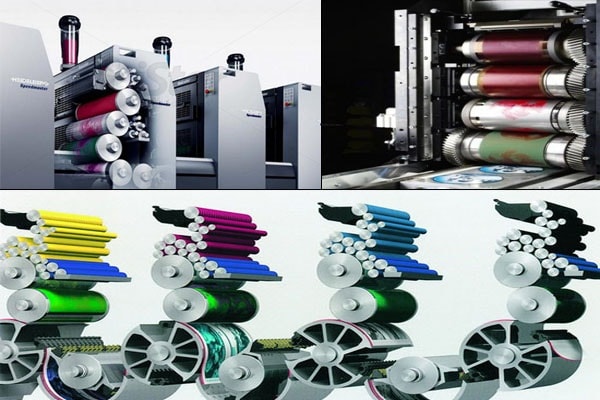
In addition to the printing units, a single-color or multi-color offset printing machine also includes the following parts:
- Paper feed unit: is responsible for sucking paper and other printing materials from the paper supply table up and down to the first printing unit.
- Feeders: (usually tubes with tweezers) capable of transporting paper through the printer.
- Paper output part: is the part that receives the output paper and pats the paper evenly into a paper tree on the paper output table.
Compare offset printing with digital printing
Both offset printing and digital printing are at the forefront of the printing industry, but offset printing can print in volumes of thousands of copies and digital printing prints one at a time. For the sake of comparison, we make the following observations:
Compared with digital printing, offset printing is more expensive because it has to use many different metal tubes with printed images in different colors to be transferred to rubber tubes and then printed on paper by television. Digital printing also uses color nozzles to create images on paper, moreover.
Digital printers all use leading printing technologies to be able to print large paper sizes from 75cm to 320cm but the time to print a copy is very short. Offset printing takes a fair amount of time to stamp and print on the paper and then let the ink dry on the paper.
Although through the above two points, offset printers are inferior to digital printers, but what about when printing with a large volume of prints? The answer is offset printing has a superior advantage.
Offset printers can print thousands of the same content with only the cost of making templates, very suitable for use in environments where multiple prints are required at the same time.
In addition, you can learn more about some other issues in Offset printing such as:

